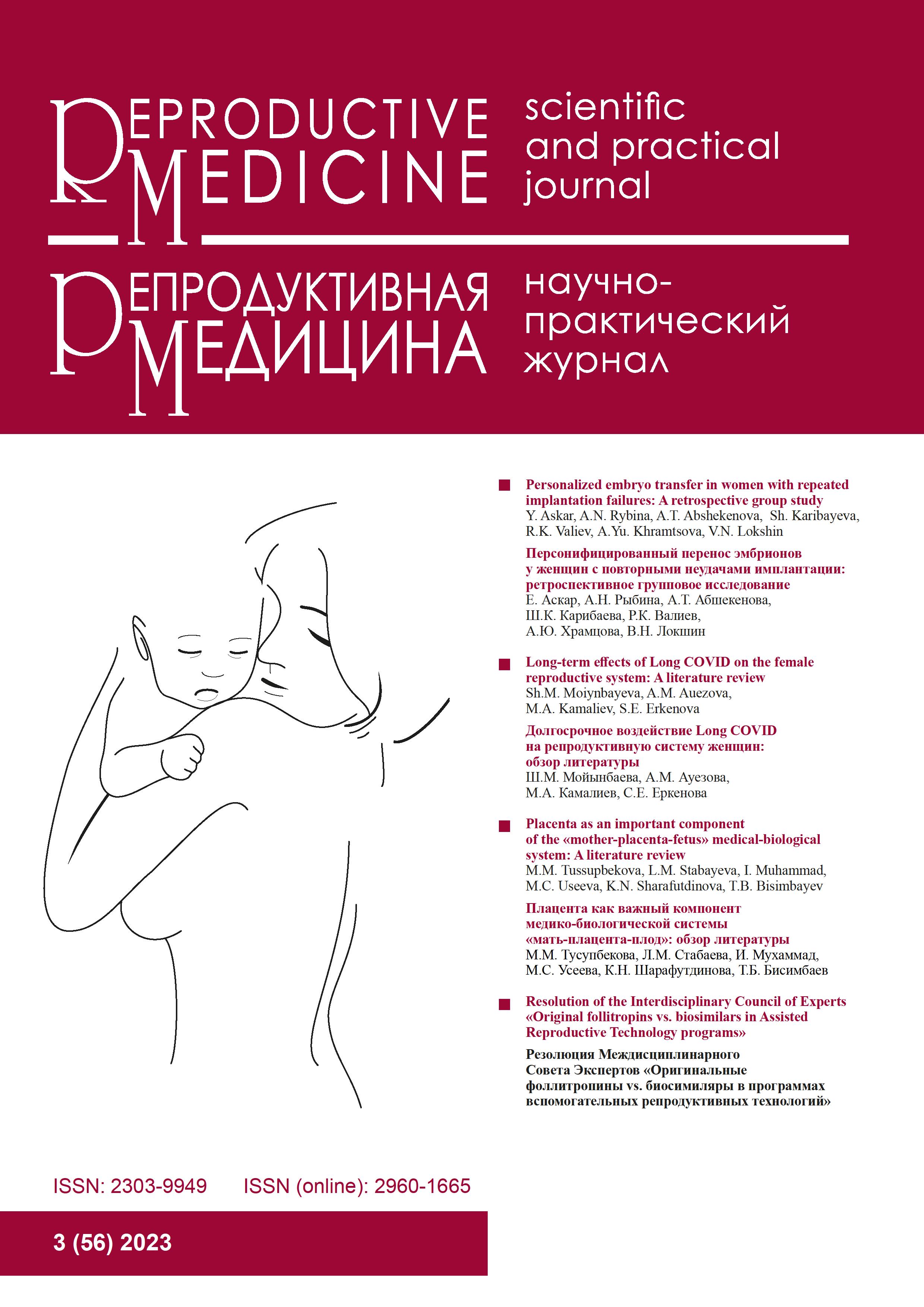Personalized embryo transfer in women with repeated implantation failures: A retrospective group study
DOI:
https://doi.org/10.37800/RM.3.2023.7-11Keywords:
Personalized embryo transfer, a window of implantation, leukemia inhibitory factor (LIF), repeated implantation failureAbstract
Relevance: Achieving a positive result in the programs of assisted reproductive technologies is possible when the endometrium and the embryo are synchronized at the time of embryo transfer, which will lead to implantation. One of the reasons for the desynchronization of the endometrium and the embryo is the shift of the window of implantation, which can be an individual feature of a woman and not just a result of chronic endometritis. Determination of the morphological “substrate” of the endometrium - pinopode - and the expression of the leukemia inhibitory factor (LIF) on the day of the intended embryo transfer with appropriate preparation of the endometrium, allows carrying out personalized embryo transfer (RET).
The study aimed to study the pregnancy rate in women with repeated implantation failures during the “implantation window” depending on the duration of progesterone intake and the level of implantation markers expression of LIF, pinopodium.
Materials and Methods: A retrospective cohort study was conducted from January 2021 to September 2022 at the private fertility unit PERSONA International Clinical Center for Reproductive Health in Almaty, Kazakhstan, performing in vitro fertilization. 51 patients with RIF underwent hysteroscopy with biopsy of the endometrium in the proliferative phase of the menstrual cycle on days 6 and 8 of taking progesterone. IGH study of LIF and pinopodes was also conducted.
Results: The frequency of clinical pregnancy after personalized transfer in group 1 was 60% (9 patients); in group 2 - 52.9% (27 patients), p=0.63. In group 2, patients who previously had a positive result received a positive result during personalized transfer, comparable to the general population.
Conclusion: A shift of the “implantation window” can lead to unsuccessful attempts to apply assisted reproductive technologies. A change in the time frames of the development of pinopode and abnormal expression of LIF in the endometrium leads to implantation failures since there is no synchronous readiness of the endometrium and embryo for implantation. Therefore, the standard transfer of embryos leads to failure. Personalized embryo transfer (RET) increases the chance of pregnancy in women with a sliding window implantation.
References
Lessey B.A., Young S.L. What exactly is endometrial receptivity? // Fertil. Steril. – 2019. – Vol. 111. – P. 611-617. https://doi.org/10.1016/j.fertnstert.2019.02.009
Brosens J.J., Salker M.S., Teklenburg G., Nautiyal J., Salter S., Lucas E.S. Uterine selection of human embryos at implantation // Sci. Rep. – 2014. – Vol. 4. – P. 3894. https://doi.org/10.1038/srep03894
Dahdouh E.M., Balayla J., Garcia-Velasco J.A. Impact of blastocyst biopsy and comprehensive chromosome screening technology on preimplantation genetic screening: a systematic review of randomized controlled trials // Reprod. BioMed. Online. – 2015. – Vol. 30(3). – P. 281-289. https://doi.org/10.1016/j.rbmo.2014.11.015
Tan J., Kan A., Hitkari J., Taylor B., Tallon N., Warraich G., Yuzpe A., Nakhuda G. The role of the endometrial receptivity array (ERA) in patients who have failed euploid embryo transfers // J. Assist Reprod Genet. – 2018. – Vol. 35(4). – P. 683-692. https://doi.org/10.1186/s40738-019-0059-7
Аскар Е., Рыбина А., Абшекенова А., Локшин В., Карибаева Ш., Валиев Р. Экспрессия LIF у женщин с повторны- ми неудачами имплантации и хроническим эндометритом // Репрод. Мед. – 2023. – №1(54). – С. 25-28 [Askar E., Rybina A., Abshekenova A., Lokshin V., Karibaeva Sh., Valiev R. Jekspressija LIF u zhenshhin s povtornymi neudachami implantacii i hronicheskim jendometritom // Reprod. Med. – 2023. – №1(54). – S. 25-28 (in Russ.)]. https://doi.org/10.37800/RM.1.2023.25-28
Díaz-Gimeno P., Ruiz-Alonso M., Blesa D., Bosch N., Martínez-Conejero J.A., Alamá P., Garrido N., Pellicer A., Simón C. The accuracy and reproducibility of the endometrial receptivity array is superior to histology as a diagnostic method for endometrial receptivity // Fertil. Steril. – 2013. – Vol. 99(2). – P. 508-517 https://doi.org10.1016/j.fertnstert.2012.09.046
Díaz-Gimeno P., Horcajadas J.A., Martínez-Conejero J.A., Esteban F.J., Alama P., Pellicer A., Simon C. A genomic diagnostic tool for human endometrial receptivity based on the transcriptomic signature // Fertil Steril. – 2011. – Vol. 95(1). – P. 50-60. https://doi.org/10.1016/j.fertnstert.2010.04.063
Bassil R., Casper R., Samara N., Hsieh T.B., Barzilay E., Orvieto R., Haas J. Does the endometrial receptivity array really provide personalized embryo transfer? // J. Assist. Reprod. Genet. – 2018. – Vol. 35(7). – P. 1301-1305. https://doi.org/10.1007/s10815-018-1190-9
Tran H.P., Tran T.T., Le L.T., Pham B., Vu S.N., Ly L.T., Hoang T.T. The impact of an endometrial receptivity array on personalizing embryo transfer for patients with infertility: a meta-analysis // F&S Reviews. – 2022. – Vol. 3(3). – P. 157-173. https://doi.org/10.1016/j.xfnr.2022.06.002.
Aunapuu M., Kibur P., Järveots T., Arend A. Changes in morphology and presence of pinopodes in endometrial cells during the luteal phase in women with infertility problems: A pilot study // Medicina (Kaunas). – 2018. – Vol. 54(5) – P. 69. https://doi.org/10.3390/medicina54050069
Downloads
Published
How to Cite
Issue
Section
License
Copyright (c) 2023 Reproductive Medicine

This work is licensed under a Creative Commons Attribution-NonCommercial-NoDerivatives 4.0 International License.
The articles published in this Journal are licensed under the CC BY-NC-ND 4.0 (Creative Commons Attribution – Non-Commercial – No Derivatives 4.0 International) license, which provides for their non-commercial use only. Under this license, users have the right to copy and distribute the material in copyright but are not permitted to modify or use it for commercial purposes. Full details on the licensing are available at https://creativecommons.org/licenses/by-nc-nd/4.0/.




